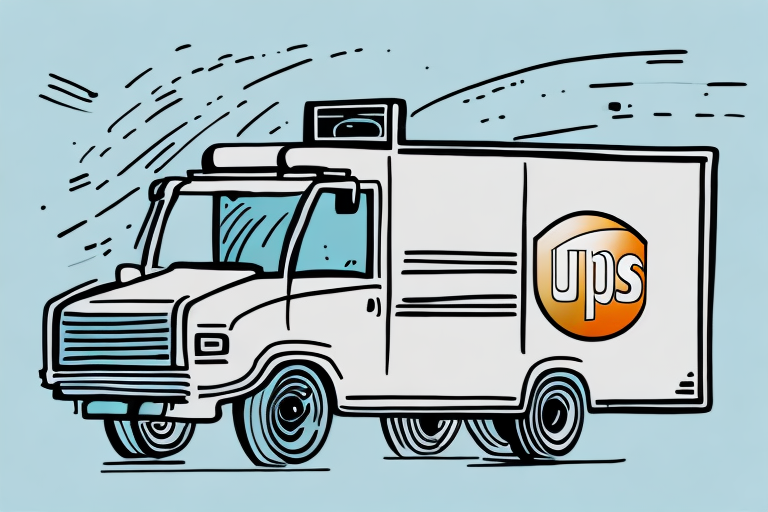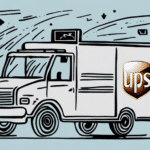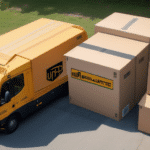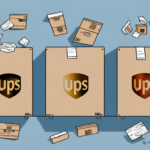What is UPS SurePost? An Overview of the Delivery Process
UPS SurePost is a collaborative shipping service offered by UPS and the United States Postal Service (USPS). It combines UPS's robust transportation network with USPS's extensive local delivery services, providing a cost-effective solution for delivering lightweight and non-time-sensitive packages. This article delves into the fundamentals of UPS SurePost, explaining how it works, its benefits and limitations, tracking capabilities, common issues, cost comparisons, and preparation tips for optimal use.
Understanding the Basics of UPS SurePost
Basics of UPS SurePost
UPS SurePost is a shipping service designed for businesses seeking affordable and efficient delivery solutions. It's ideal for lightweight (typically less than 1 pound) and non-urgent packages requiring residential delivery across the 50 states, Puerto Rico, and the US Virgin Islands. This service leverages UPS's transportation network to transport packages to USPS delivery centers, where USPS handles the final delivery to the customer's doorstep.
Advantages Over Other UPS Services
One of the primary advantages of UPS SurePost is its cost-effectiveness compared to other UPS services like Ground or Air. By utilizing USPS for the last-mile delivery, UPS SurePost benefits from USPS's extensive residential delivery network, which helps reduce overall shipping costs. Additionally, UPS SurePost provides tracking information, enabling businesses to monitor their shipments and ensure timely delivery.
How UPS SurePost Works
The UPS SurePost process begins with creating a shipment through the UPS website or the UPS WorldShip application. When setting up the shipment, you select UPS SurePost as the service level and input the package's dimensions and weight. Once the shipment is created, UPS picks up the package from your location and transports it to a USPS delivery center. USPS then sorts and delivers the package to the final destination using their local mail carriers.
Step-by-Step Shipping Process
- Create Shipment: Use the UPS website or UPS WorldShip to initiate the shipment and select UPS SurePost.
- UPS Pickup: UPS collects the package from your specified location.
- Transportation to USPS: UPS transports the package to a local USPS delivery center.
- USPS Final Delivery: USPS handles the last-mile delivery to the recipient's address.
Role of USPS in UPS SurePost
USPS plays a crucial role in the UPS SurePost service by managing the final delivery stage. Once UPS transfers the package to USPS, the local USPS carriers take responsibility for delivering the package to the recipient's address. This collaboration allows for broader coverage, especially in residential areas, leveraging USPS's established delivery network.
Benefits of Using UPS SurePost
Cost-Effectiveness for E-commerce Businesses
UPS SurePost is particularly beneficial for e-commerce businesses looking to reduce shipping costs without compromising delivery reach. By combining UPS's efficient transportation with USPS's affordable residential delivery, businesses can save significantly on shipping expenses. This is especially advantageous for businesses that ship a high volume of lightweight packages where cost savings can accumulate substantially.
Flexible Delivery Options
UPS SurePost offers flexibility in delivery options, allowing businesses to customize how they deliver packages. Options include:
- Residential Delivery: Ensures packages reach customers at their doorsteps.
- Delivery to UPS Access Points: Customers can choose to pick up their packages from UPS locations, offering convenience for those not available at home during delivery times.
- Delivery Confirmation and Tracking: Provides real-time tracking updates and delivery confirmation, enhancing customer satisfaction and trust.
Enhanced Customer Experience
With UPS SurePost's reliable tracking and residential delivery services, businesses can offer a better customer experience. Customers receive timely updates about their shipments and have the assurance of package delivery to their preferred address, increasing overall satisfaction and loyalty.
Limitations of Using UPS SurePost
Not Suitable for Time-Sensitive Deliveries
While UPS SurePost is cost-effective, it is not ideal for time-sensitive or urgent deliveries. Packages delivered via UPS SurePost typically take longer—ranging from 2 to 7 business days—compared to expedited shipping services like UPS Next Day Air or UPS 2nd Day Air. Businesses that require guaranteed delivery within specific timeframes should consider alternative UPS services that offer faster transit times and enhanced delivery guarantees.
Limited Availability in Remote Areas
UPS SurePost may not be available in all geographic locations, particularly in remote or rural areas where USPS may have limited delivery infrastructure. It's essential to verify the availability of UPS SurePost for your intended delivery destinations to ensure serviceability and prevent potential delivery delays or the need for alternative shipping methods.
Potential for Package Damage or Loss
As with any shipping service, there is always a risk of package damage or loss during transit. UPS SurePost packages are handled by both UPS and USPS, increasing the potential points where mishandling can occur. To mitigate these risks, it is important to package items securely using adequate padding and protection. Additionally, opting for UPS SurePost's package protection services can provide coverage in the event of lost or damaged packages.
Tracking and Monitoring Your UPS SurePost Package
Tracking Features
UPS SurePost offers comprehensive tracking capabilities, allowing both businesses and customers to monitor the status of their packages throughout the delivery process. Tracking is available via the UPS website or mobile app during the initial transit phase. Once USPS takes over for final delivery, tracking information can also be accessed through the USPS website or mobile app.
Dealing with Tracking Updates Delays
During the transition of a package from UPS to USPS, there can occasionally be a delay in tracking updates. This lag occurs due to the transfer of information between the two carriers. If you experience delays in tracking updates, rest assured that your package is still en route and should arrive within the estimated delivery window provided by UPS. It's advisable to communicate these potential delays to customers to manage expectations effectively.
Common Issues with UPS SurePost Delivery and How to Resolve Them
Delayed Deliveries
Delayed deliveries can occur due to various factors, including logistics issues, high shipping volumes, or operational challenges within USPS. To mitigate delays:
- Ensure package information is accurate and complete at the time of shipping.
- Choose UPS SurePost only for non-urgent packages to set appropriate delivery expectations.
- Monitor shipment tracking regularly and proactively communicate with customers about any potential delays.
Lost or Stolen Packages
Packages can sometimes be lost or stolen during transit or after delivery. To address this issue:
- Invest in secure packaging to deter theft.
- Utilize tracking services and delivery confirmations to verify receipt.
- Consider purchasing insurance or utilizing UPS SurePost's package protection services to cover potential losses.
Incorrect Address Information
Incorrect shipping addresses can lead to delivery failures or packages being returned to the sender. To prevent this:
- Double-check recipient address details before shipping.
- Use address validation tools available through UPS to ensure accuracy.
- Communicate with customers to confirm their preferred and correct address for delivery.
Cost Comparison: UPS SurePost vs Other Shipping Methods
UPS SurePost Compared to Other UPS Services
When comparing UPS SurePost to other UPS shipping options, it stands out as a more economical choice for non-urgent and lightweight packages. For example:
- UPS Ground: Offers guaranteed delivery times but at a higher cost compared to UPS SurePost.
- UPS 2nd Day Air: Provides faster delivery for time-sensitive packages but comes at a premium price.
- UPS Next Day Air: Delivers packages overnight but is the most expensive option in the UPS shipping suite.
Advantages of UPS SurePost for Cost Savings
By leveraging USPS's local delivery network, UPS SurePost reduces overall shipping costs, making it an attractive option for businesses aiming to minimize expenses. This cost savings is particularly beneficial for high-volume shippers where the cumulative reduction in shipping costs can be substantial.
Pricing Structure Insights
UPS SurePost typically charges a lower shipping rate compared to other UPS services due to the shared transportation responsibilities between UPS and USPS. This hybrid approach allows UPS to offer competitive pricing while maintaining efficient delivery operations. For detailed pricing information, businesses can refer to [UPS shipping rates](https://www.shipscience.com/understanding-ups-shipping-rates-for-your-business-2/) on the official UPS website.
Preparing Your Package for UPS SurePost Delivery
Proper Packaging Techniques
Ensuring your package is securely packed is essential for successful delivery through UPS SurePost. Follow these guidelines to prevent damage during transit:
- Use sturdy boxes or envelopes that can withstand handling and transportation.
- Add sufficient padding materials like bubble wrap or packing peanuts to protect the contents.
- Seal packages securely with strong packing tape to prevent accidental openings.
Eligible Package Contents
UPS SurePost is best suited for non-hazardous, non-perishable items. Certain products are restricted or require special handling, including:
- Hazardous Materials: Items classified as hazardous are typically prohibited from UPS SurePost delivery.
- Perishable Goods: Products that require temperature control or expedited delivery may not be suitable.
- High-Value Items: While coverage is available, additional insurance may be necessary for valuable shipments.
Considering Transit Time
Given that UPS SurePost is not designed for expedited delivery, it's important to factor in the estimated transit time (typically 2-7 business days) when preparing packages. Communicate expected delivery times clearly to customers to manage expectations effectively. Plan shipments accordingly, especially during peak seasons when delivery times may be extended.
In summary, UPS SurePost is an excellent shipping solution for businesses seeking a cost-effective and reliable method for delivering lightweight, non-urgent packages. By understanding its workings, benefits, limitations, and proper preparation techniques, businesses can optimize their shipping operations, enhance customer satisfaction, and achieve significant cost savings. For further assistance or specific inquiries about using UPS SurePost, contacting UPS Customer Service is recommended.






















